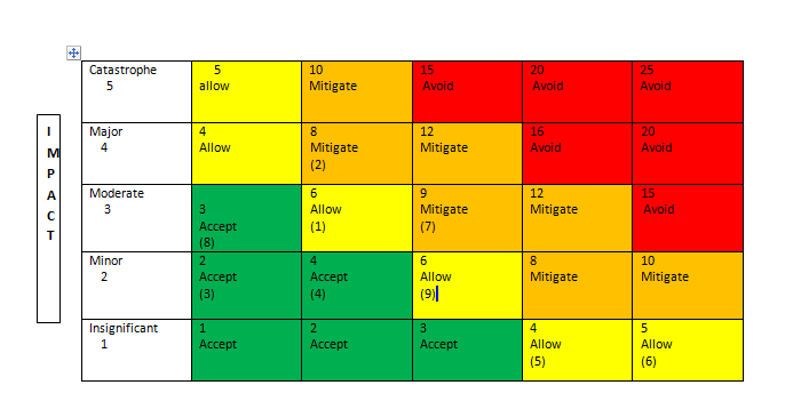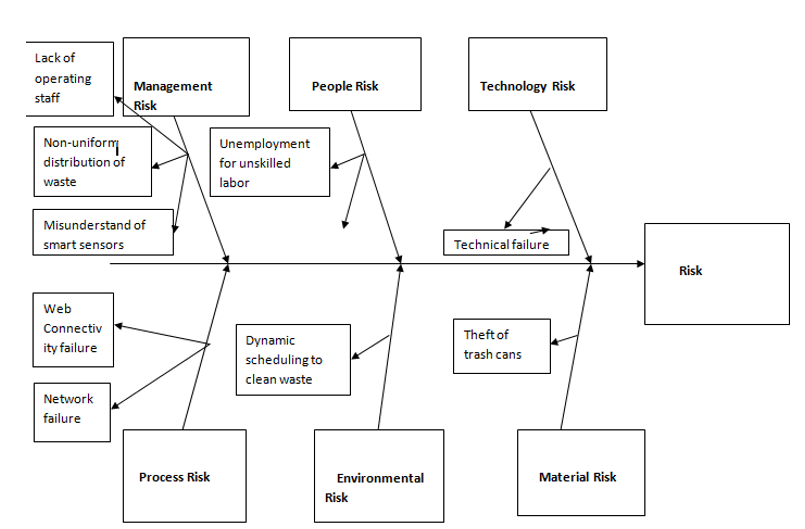Lot Based Smart Waste Bins and Waste Management System Risk Management Assignment Sample
1.0 Introduction
This assignment is based on the risk identification and management of the project engaged with IOT based bins and waste management systems. The risk management is analyzed with STEEPCOIL for categorizing the risks of the project. There is the use of risk registered and risk mitigation mapping for the project to analyze the risks.
2.0 Discussion
Risk analysis:
| Social | Technological | Economic |
| Chances of theft as the trash can be operated from outdoor | Internet connection failure | Operating cost |
| Environmental | Political | Commercial |
| Difficult weather conditions may lead to signal loss and technical failure | Increasing unemployment for the workers who are not skilful. | Failure supply of the product |
| Organizational | Information technology | Legal |
| Failure of supply and web connection may mash up the targets | Failure of connectivity may occur in the network | Non-uniform waste distribution of waste in bins |
| Operating staff or humans is essential for filling the requirement | The operation of smart sensors can be misunderstood |
Table 1: Risk analysis of the project by STEEPCOIL
(Source: Self-created)
In this section of this report, some risk identification and management issues have been described. There are some risks that have been identified based on many sectors. In this project, it can be found that the supplier can fail in providing resources and some failures can be found on the web. These flaws can be abused by the targets. In the process of the project, the support of humans and support is required in a high manner and it plays an essential role to achieve the perspective of the environment. Some flaws in support can be trash the operating system (Sheng, et al. 2020). There are some possibilities of robbery of the materials and some social issues about the operating system from the outside. It can be found that workability can reduce the labour need and increase the rate of unemployment. Some environmental risk is also found as it is difficult to manage the behaviour of the environment. The unexpected condition of the weather can be a cause of technical issues. Following the issue of the network, there will be some issues of connectivity because of the absence of a network. The management system is indeed more intelligent to avoid confusion in the operating system which includes smart operations (Sheng, et al. 2020). It needs to be sure about the distribution of the waste products. As some products can be reused after the recycling process, and the products that can not be used in the future the distribution is needed to keep them separate. There are some risks to the management of the waste products, so there will be a scheduling process to manage the waste products and clean up the places. In the economic sector, the operating of the costs management ts can be considered as risk mitigation.
Risk register:
| Risk id | Risk name | Risk description | Risk category | Risk owner | Risk trigger(s) |
| 1 | Failure of supply and web connectivity | Due to the failure of web connectivity the target can be mashed up. | Organizational | Project manager | Improvement of web connectivity. |
| 2 | Lack of operating staff | The requirement cannot be fulfilled due to a lack of operating staff. | Organizational | Project manager | Need a change in management. |
| 3 | Possibility of theft | As the trash cans are outdoor, so is the possibility of theft. | Social | Project manager | Need a proper security step to the bin. |
| 4 | Increase in unemployment | Reduce the need for labourers and increase the unemployment rate. | Political | Project manager | Need engagement of the skilled employee. |
| 5 | Technical failure or signal loss | Technical failure can occur due to unexpected weather conditions. | Technological | Project manager | Need proper support to reduce technical failure. |
| 6 | Failure of connectivity | Failure of connectivity occurs due to a network system. | Information technology | Project manager | Provide a better connection. |
| 7 | Disability of using smart sensors | There is a lack of proper understanding about the operation of waste in bins. | Information technology | Project manager | Provide Latest technology |
| 8 | Non-uniform waste distribution | Risk occurs when the non-uniform distribution of waste has been done in bins. | Legal | Project manager | Up-gradation of the waste distribution system. |
| 9 | Lack of dynamic scheduling | It is not followed to clean the waste in proper dynamic scheduling. | Environmental | Project manager | Proper dynamic scheduling can be provided for waste management. |
| Risk Id | Pre-mitigation probability | Pre-mitigation impact | Pre-mitigation rating | Mitigation strategy |
| 1 | 3 | 4 | 12 | By supplying proper web connectivity with the IoT based smart waste bins can mitigate the risk. |
| 2 | 2 | 5 | 10 | For managing the waste management system adequate quantity of operating staff is required who have knowledge about waste management. |
| 3 | 3 | 5 | 15 | There must be a way to protect the waste bin as the trash cans are operated outdoors and it will decrease the possibility of theft. |
| 4 | 2 | 4 | 8 | The government has to look out this case how to decrease the unemployment rate and how the unskilled labourers are provided proper knowledge and then recruit them into this system. |
| 5 | 3 | 3 | 9 | An alternative way must be there that will work in any unexpected weather condition so that technical failure can be avoided. |
| 6 | 4 | 3 | 12 | A proper connection to connect easily in bad weather. |
| 7 | 5 | 1 | 5 | People have to provide knowledge about the operation of smart sensors. |
| 8 | 4 | 41 | 4 | Different types of bins for a different types of wastes. |
| 9 | 3 | 2 | 6 | Dynamic scheduling is needed for cleaning the wastes. |
| Risk Id | Post mitigation probability | Post mitigation impact | Post mitigation rating | Status |
| 1 | 3 | 3 | 6 | Open |
| 2 | 2 | 4 | 8 | Open |
| 3 | 2 | 1 | 2 | Open |
| 4 | 2 | 2 | 4 | Open |
| 5 | 1 | 4 | 4 | Open |
| 6 | 5 | 1 | 5 | Open |
| 7 | 3 | 3 | 9 | Open |
| 8 | 1 | 3 | 3 | Open |
| 9 | 2 | 3 | 6 | Open |
Table 2: Risk register
(Source: self-created)
The risk register table has presented the risk and mitigations of the waste bins and waste management system.

Figure 1: Risk matrix Pre- mitigation
(Source: Self-created)
The matrix Pre- mitigation has included the rate of the risks, as the risks are high or low and their impact on the waste bins and waste management system.

Figure 2: Risk matrix post-mitigation
(Source: self-created)
Matrix post-mitigation, after the pre-mitigation process the further risk are included, their risk, and their impact on the waste bins and waste management system.

Figure 3: Ishikawa diagram showing the major risks
(Source: Self-created)
In this risk management assignment, management risk is very high as the overall management is required to mitigate the risks developed in the IoT waste management system.
There are some risk management strategies to mitigate the risks. Proper connectivity with the network and a better waste management system is necessary (Soh, et al. 2019). The government should also increase the employment rate of unskilled labour. Smart sensors and other mitigation strategies are developed mentioned in the above table.
3.0 Conclusion
The report presents the methods and strategies for the risk identification and management of the project engaged with IOT based bins and waste management systems. The risk management is analyzed with STEEPCOIL for categorizing the risks of the project. There is the use of risk registered and risk mitigation mapping has been included for the project to analyze the risks. There are many tables are presented which include some strategies.
Reference list
Journals
Kumar, S.V., Kumaran, T.S., Kumar, A.K. and Mathapati, M., 2017, August. Smart garbage monitoring and clearance system using the internet of things. In 2017 IEEE International Conference on Smart Technologies and Management for Computing, Communication, Controls, Energy and Materials (ICSTM) (pp. 184-189). IEEE.
Mdukaza, S., Isong, B., Dladlu, N. and Abu-Mahfouz, A.M., 2018, October. Analysis of IoT-enabled solutions in smart waste management. In IECON 2018-44th Annual Conference of the IEEE Industrial Electronics Society (pp. 4639-4644). IEEE.
Pardini, K., Rodrigues, J.J., Diallo, O., Das, A.K., de Albuquerque, V.H.C. and Kozlov, S.A., 2020. A smart waste management solution geared towards citizens. Sensors, 20(8), p.2380.
Sheng, T.J., Islam, M.S., Misran, N., Baharuddin, M.H., Arshad, H., Islam, M.R., Chowdhury, M.E., Rmili, H. and Islam, M.T., 2020. An internet of things based smart waste management system using LoRa and tensorflow deep learning model. IEEE Access, 8, pp.148793-148811.
Soh, Z.H.C., Husa, M.A.A.H., Abdullah, S.A.C. and Shafie, M.A., 2019, April. Smart waste collection monitoring and alert system via IoT. In 2019 IEEE 9th Symposium on Computer Applications & Industrial Electronics (ISCAIE) (pp. 50-54). IEEE.
Xenya, M.C., D’souza, E., Woelorm, K.O.D., Adjei-Laryea, R.N. and Baah-Nyarkoh, E., 2020, March. A Proposed IoT Based Smart Waste Bin Management System with An Optimized Route: A Case Study of Ghana. In 2020 Conference on Information Communications Technology and Society (ICTAS) (pp. 1-5). IEEE.
………………………………………………………………………………………………………………………..
Know more about UniqueSubmission’s other writing services:

